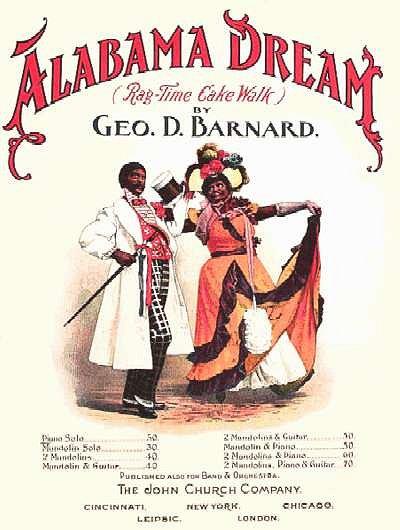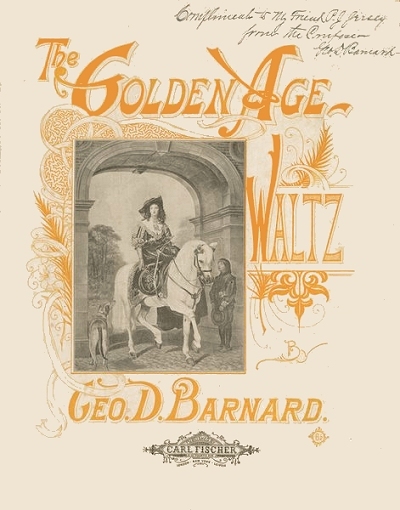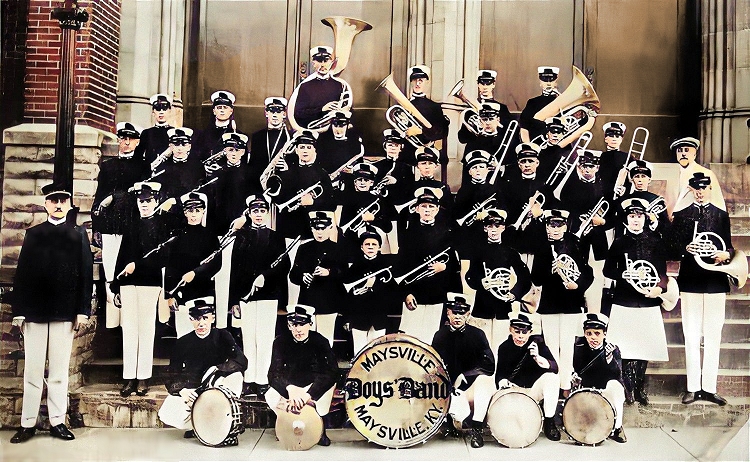|
George Daniel Barnard (October 14, 1857 to January 19, 1933) | |
 Compositions Compositions | |
|
1890
Conglomeration: OvertureFestival Quadrille 1891
Gems of Ireland: OvertureThe Old Warrior: March The Old Veteran: March Comrades: Patrol 1892
Flee as a BirdBig and Little Cassino 1893
The Fourth of July Celebration1897
Anita: Mexican Waltzes1898
Society Belle Lancers1899
Alabama Dream: Cakewalk1900
Smart Set MarchKissed by the Man in the Moon [w/Ralph T. Butler] 1901
Love in the Moonlight: Waltzes1902
Imozetta: Mexican Gypsy DanceThe Little Trifler: Intemezzo Jocoso Nourhalma Waltzes: Love Legend 1903
Mississippi Rose: Characteristic MarchAntics of the Ants: An Antique March [w/Scouton] 1904
Cross Country: Descriptive March1905
Miss-OuriPride of the Band Salute to the General: March Hearts of Gold 1906
The Golden Age: WaltzAlliance Overture Present Greeting: March Enchantment: Serenade Starlight Fancies: Serenade The Dasher Hero's Sacrifice: Dirge King Rose: Overture Logan Court-House March Western Boy: March Sincerity: Overture Paragon: Overture The Pals: Polka 1907
Passions of the Heart: WaltzesLittle Rosebud: Mazurka Velvet of the Rose: Waltzes Golden Rod Schottische 1908
Prosit: Descriptive MarchFlower of Love: Waltzes Punch and Judy Slippery Sam The Observer: March The Drummer's Escapade Adoration: Flower Song Blackberry Bill: March Reign of Youth: Waltzes Tranquility St. Haskins' Barn Dance |
1908 (Cont)
Moana WaltzIsle of Beauty: Overture 1909
Jungle Queen: Oriental Two-StepGarden of Eden The Wurlitzer Operatic Band Book The Lovers: Serenade 1910
A Cyclone in Darktown: Just RagsThe Tantic: Overture Concert Quartettes: Bohemian Girl Schubert Serenade The Palms 1911
ArbitrationPeace and Liberty: March 1912
Chiquita: Spanish WaltzesHappy-Go-Lucky: March In Love's Domain: Waltzes Dream of Paradise: Waltzes The Empire: Medley Overture 1913
Big Four: A Collection of Cornet QuartettesCrown Prince Overture Prince Royal Royal Pageant The Barnard: Virginia Reel Merriment Polka The Crescent 1914
Love and Loyalty: Grand Sacred SelectionJune Rose 1915
Sing, Oh Sing, This Blessed Morn1916
Gloriana: Theme and VariationsThe Wedding Ring 1917
Kingdom of Dreams1919
Bridal Roses1921
The Chieftan: March1922
Kentucky CardinalLa Fatiana: Mexican Serenade 1923
ParamountGolden Sunset King of the Night 1924
Jupiter's Carnival1926
Old Time FavoriteColumbia: Grand Patriotic Potpourri 1927
The Celestial Series Band Book #1The Celestial Series Band Book #2 The Celestial Series Band Book #3 The Celestial Series Band Book #4 1927
Glory of YouthUnknown/Uncertain
Ann Arbor UniversityNormandie: Overture Hurly-Burly Galop Golden Leaf Polka |
One of the earliest published composers of syncopated music, George Barnard actually contributed more to American band music, and band programs for youth. He was born in late 1857 nearly four decades before ragtime was first heard by the general public. George was the youngest child of Michigan farmer Daniel O. Barnard and his bride Rebecca A. Bunker. His older siblings included William Stuart (5/23/1842), Emily (8/13/1845), Charles (3/1847), Luther James (1851-1871) and Roland (1853-1862). While George's birth year has been traditionally reported as 1858, he himself noted 1857, and since he was 2 in August 1860, 12 in June 1870 and 22 in June 1880, these are all consistent with the 1857 birth year which is used here. Also, his original home was Sandstone in Jackson County, Michigan, not Jackson itself. The Barnard family was shown there in both the 1860 and 1870 census enumerations.
As a youth he received some musical training, but spent much of his own time and initiative learning various band instruments. In his early twenties he was knowledgeable enough about both instruments and band orchestrations that he was able to get a job working for music dealer, instrument maker and sometime publisher Lyon and Healy of Chicago. On August 16, 1879, George married his first wife, Jennie McQuaid (McQuaid was her birth name, but Roby was her stepfather's name which may have also been used), and she often accompanied him as he traveled the country peddling the Lyon and Healy products. But it is probable that George was also playing in various bands, and perhaps doing some piano performance as well. In the 1880 census, living in East Saginaw, Michigan with his new bride, George was listed as a musician. His mother had been widowed by that time, and was living in Jackson with her son Charles.
But it is probable that George was also playing in various bands, and perhaps doing some piano performance as well. In the 1880 census, living in East Saginaw, Michigan with his new bride, George was listed as a musician. His mother had been widowed by that time, and was living in Jackson with her son Charles.
 But it is probable that George was also playing in various bands, and perhaps doing some piano performance as well. In the 1880 census, living in East Saginaw, Michigan with his new bride, George was listed as a musician. His mother had been widowed by that time, and was living in Jackson with her son Charles.
But it is probable that George was also playing in various bands, and perhaps doing some piano performance as well. In the 1880 census, living in East Saginaw, Michigan with his new bride, George was listed as a musician. His mother had been widowed by that time, and was living in Jackson with her son Charles.George learned more about band orchestrations during his travels and experiences with bands. By 1890 he was dabbling in composition, and Lyon and Healy utilized him as an arranger as well. Many of his early compositions were published in Philadelphia by the John Church company. Barnard had the advantage of being exposed to what was often the newest type of music in one or another location, then spreading the idea of that form to other places he visited. In 1897 he wrote his first of many waltzes, which was also a Spanish-tinged serenade, a form he would revisit again. Two years later, during the height of the cakewalk craze, George contributed his own durable entry, Alabama Dream. Even though most cakewalks were fairly good sellers, well written ones like Alabama Dream did even better. It was played by many bands and pianists around the country.
As of the 1900 census, George and Jennie were living in Cincinnati, Ohio, with her mother, Matilda A. Roby. They had been there for perhaps eight years by that time. Most of his compositions over the next few years shied away from syncopation, and were comprised largely of marches, waltzes and overtures. In 1902 the Barnards moved again, this time to Lincoln, Nebraska, where he was given the task of directing French's Military Band.
He gave up representation of Lyon and Healy around that time. In 1907 George and Jennie moved again, this time back to Michigan and Calumet where he both played with and directed the Calumet and Hecla Band. This was one of many organizations around the country that was largely comprised of miners and their families, in this case, copper miners. He was also in the middle of a composing fury, turning out several original works and arrangements between 1906 and 1909. His primary publisher of the time, Carl Fischer, proclaimed Barnard to be one of the finest waltz writers of the new century. Sadly, George and Jennie were divorced in mid-1907 during his tenure in Michigan, a status also reflected in the 1910 Federal census.
 |
Even though cakewalks were more or less passé by 1910, and "coon songs" were thankfully on their way out, Barnard added one more entry to that genre with A Cyclone in Darktown: Just Rags. The sheet music sported an unfortunate cover featuring a black man running from "darktown" holding a razor in one hand and a watermelon in the other. This was the responsibility of publisher Carl Fischer than Barnard, who more or less left that part of the business decision making alone. A Cyclone in Darktown had more syncopation in it than Alabama Dream, but was only a moderate seller in a time when songs about ragtime were becoming more popular than the ragtime itself.
Barnard would continue his composition career within the three genres he was more comfortable with, waltzes, marches and Latin serenades. There were a few piano pieces published, but most would end up as band or orchestral arrangements. While in Michigan George met and married his second and last wife, Hortencia "Daisy" Weismann, twenty years his junior, on December 26, 1908. She was the sister of Leonard Weismann, a cornet player in Barnard's band. In 1913 the couple left Michigan for Oskaloosa, Iowa, for a year, then in 1914 moved to Oklahoma, spending the remainder of the decade in Ardmore in the south-central part of the state. Leonard followed along as a member of George's stock company, and played for many years in a band there. He and Daisy were found in Ardmore, Oklahoma in the January 1920 census, with George listed as a band master working from home.
In mid-1920 George and Daisy relocated one last time, settling in Maysville, Kentucky. There he took over leadership of the Kentucky Cardinals Boys Band, which had been founded in Maysville in February 1919. This was a pioneering organization which spawned similar bands around the country as their reputation grew. It was also a quality unit, with George arranging most of the music they played, assisted by J. Barbour Russell who managed the organization.
Billed as the "wonder of the age," on one occasion at the Kentucky State Fair, a ceremony was held to honor Barnard and his band, with an extensive blue ribbon wrapped around everybody, standing for the Blue Ribbon quality and the Blue Grass of Kentucky, and their "pride and joy." He also soon took over leadership of the local high school band, and the Horseshoe Boys Band. The bands were only in session during the school year, so Leonard would come down from Michigan and they would play on the Ohio River excursions during the summer. They also went on some longer trips along the Ohio and Mississippi, as far north as Pittsburgh, Pennsylvania and down to the delta at New Orleans, Louisiana.
 |
Having accumulated some wealth through his compositions, arrangements, endorsements and band leadership, Barnard had a home custom built for him and his wife. It had a music room large enough to host a small band, and it is said there was a large bass drum on one side with a cardinal logo. Barnard entertained and also taught private lessons in that room. In 1925 when a Kentucky statue was proposed concerning regulating and taxing municipalities that sponsored musical concerts, Barnard became involved with it, supporting it as good for the state. He had not flagged on composition either, continuing to turn out new arrangements, but mostly for band and not piano. In 1927 George published a series of band/orchestra books full of flexible arrangements of well-known classical and march works.
Barnard retired from his regular band work around 1927 when he turned 70, but continued to teach privately and perform or conduct now and then. Many in the mainstream of music had forgotten about or simply were not aware of this fairly prolific composer and dynamic leader, as he had always led a fairly private life away from the bandstand. He continued working at arranging and teaching until early January 1933, and was taken in his home by a cerebral hemorrhage at the age of 75 that same month. He reportedly left behind some 400 compositions, many published under various pseudonyms, including G.F. Daniels, George McQuaide, Edward Russell, Ed Hazel and M.B. Eaton. Hortensia survived him and continued to submit his pieces for recopyright for many years. Barnard's compositions and arrangements for bands remain in print to this day, some even available for digital downloads more than a century after their inception.